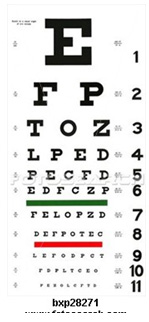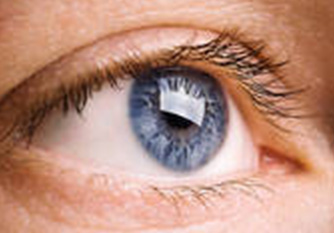
Vision plays a key role in safe driving. Seeing all around your vehicle is crucial in detecting and avoiding hazardous situations. Good vision is key to stopping your vehicle in time to avoid a collision.
Eye Physiology
- Most of what you do behind the wheel is dependent upon your eyesight. If you cannot see clearly, you cannot judge distances or spot trouble. Therefore, you won’t be able to react quickly in response to potentially hazardous situations.
- You need to see “out of the corner of your eye.” This lets you spot cars creeping up on either side of you while your eyes are on the road ahead.
- Good distance judgment is important in knowing how far you are from other vehicles. Under good conditions you need 400 feet to stop at 55 mph and 210 feet to stop at 35 mph. This implies that you can’t drive safely at 55 mph unless you can see at least 400 ft or 35 mph if you can’t see at least 210 feet.
- Many people who see clearly in the daytime have trouble seeing clearly at night. This is called “night blindness.” Also, some people may see poorly in dim light and others may have trouble with the glare of headlights.
 Visual Acuity
Visual Acuity
The sharpness of your eyesight is very important while driving a vehicle. Visual acuity is the ability to discern detail, identify and recognize what is being seen. Visual acuity is important for reading road signs and identifying hazards.
For example:
- A person who can read 3/8-inch high letters clearly from a distance of 20 feet is considered to have normal vision and is said to have “20/20” vision.
- If a person has a 20/40 vision, it means that when that person stands 20 feet away from the chart, he or she can see what a normal human can see when standing 40 feet from the chart.
Distance Judgment (Depth Perception)
 Depth perception is your ability to correctly perceive the distances of objects in relation to your own position.
Depth perception is your ability to correctly perceive the distances of objects in relation to your own position.
Depth perception is important when passing, approaching a vehicle and when turning.
Poor depth perception can result in:
- Stopping too short of limit lines or inside the intersection
- Turning too wide or too short
- Being unable to maintain a constant speed
- Being unable to follow other vehicles at a distance appropriate for driving conditions
Peripheral Vision
Peripheral vision is being able to see what is going on to the sides of you or “looking out of the corner of your eye.” No matter how good your peripheral vision is, there will still be areas to the sides and rear of your vehicle that cannot be seen. These areas are referred to as “blind spots”. Using your rear view mirror will not eliminate all blind spots, so when changing lanes you need to check for vehicles in your blind spot by turning your head and looking into the lane you want to enter.
Night Vision
Night vision refers to your ability to see well in low light levels. This is necessary for driving safely at night. Lights appear blurry and can “spread out” on the windshield causing a sheen that is difficult to see through. This makes it hard to perceive the distance and position of the light source.
Driving safely at night requires seeing well not only under low illumination, but also requires a driver to see low contrast objects. For instance, a person wearing dark clothing and crossing the street in front of a driver is much harder to detect at night because there is much less contrast between the darkly-clothed pedestrian and the dark background.
Vision, Color Blindness
Color-blindness is the inability to distinguish the differences between certain colors. This condition results from an absence of color-sensitive pigment in the cone cells of the retina, the nerve layer at the back of the eye.
A person with color-blindness has trouble seeing red, green, blue, or mixtures of these colors. The most common type is red-green color-blindness, where red and green are seen as the same color.
Drivers with color vision difficulties may pose a hazard to themselves and other users of the roadway. For instance, the controlled lighting system is based on a color system; Red: Stop, Green: Go, Yellow: yield; without being able to distinguish different colors you will be unable to tell when you should stop or go.
Compensation for Subnormal Vision
If you have vision problems, visit an optometrist and get fitted for eyeglasses or contact lenses. In severe cases, consult with an ophthalmologist.
Driving recommendations for a person to compensate for poor visual acuity:
- For poor depth perception, use extra caution in judging the speed and distance of oncoming vehicles and approaching objects.
- For poor peripheral vision, one should frequently turn one’s head to increase field of vision.
- For poor glare resistance and recovery use sun visor, wear sunglasses or other dark lenses during sunset, and avoid looking into the headlights of oncoming cars.
- For color blindness, learn the general shapes and patterns of signs and rely on the position of signal lights rather than on their color.
Common Eye and Vision Myths
It’s important to separate fact from fiction, especially when the topic is eyesight. Knowing how to take good care of your eyes is the first step to protecting your sight for a lifetime.
 Myth: Failure to use proper glasses will hurt your eyes.
Myth: Failure to use proper glasses will hurt your eyes.
Fact: This statement does have some truth for a small number of people. Some children have eye problems that can be corrected and it is important that they wear their glasses. While corrective glasses or contacts are needed to improve eyesight, using your eyes with or without glasses will not damage them further.
 Myth: Reading in dim light can damage your eyes.
Myth: Reading in dim light can damage your eyes.
Fact: Reading in dim light can cause eye fatigue but it will not hurt your eyes.
 Myth: Eating carrots will improve your vision.
Myth: Eating carrots will improve your vision.
Fact: While it is true that carrots are high in Vitamin A, which is an essential vitamin for sight, only a small amount is necessary for to help vision.
 Myth: An eye exam is only necessary if you’re having problems.
Myth: An eye exam is only necessary if you’re having problems.
Fact: Everyone should follow a proper eye health program that includes a regular eye exam, whether or not they’re having any noticeable signs of problems
 It is important to wear your eyeglasses or corrective contact lenses while driving; the Department of Motor Vehicles may suspend or revoke your license if you violate this restriction.
It is important to wear your eyeglasses or corrective contact lenses while driving; the Department of Motor Vehicles may suspend or revoke your license if you violate this restriction.
How Does Vision Work?

1. When a person views external objects, the light rays strike the eye and then pass through the cornea, pupil, aqueous humor, lens and vitreous humor.
2. Once they reach the retina, the rods and cones are stimulated.
3. An upside-down image is relayed along nerve impulses to the optic nerve.
4. The images are transferred to the brain and the brain turns the images into a right-side-up image.
5. The image is the one that the person sees.
Vision Care
Certain aspects of vision deteriorate slowly with age, sometimes so slowly that people do not notice the change. It is important to have your eyes checked every year or two by an optometrist or ophthalmologist to ensure that you are not putting yourself and others at risk while driving.
Things to Consider to Help Vision While Driving
- To provide good visibility, it is important to keep your widows clean and to clear away objects inside the vehicle that may obstruct your vision. Don’t hang anything on the inside rear-view mirror.
- Putting stickers, signs and other objects on your windows can adversely affect your vision.
- Tinted windows must meet standards as to the degree to which they are tinted and the location of the tinting.
- Adjust the mirrors on your vehicle before you begin driving. To do this: first adjust the seat so that you have good visibility and are comfortable looking ahead, use a seat cushion if necessary and then adjust your mirrors.
- It is illegal to drive a motor vehicle equipped with a television or similar device that is visible to the driver while operating the motor vehicle.
- Windshield wipers should be kept in good operating condition and be used whenever necessary to ensure clear vision through the windshield including during conditions of fog, snow or rain.
Why do I need to wear sunglasses? Sunglasses can help your eyes in two important ways.
Sunglasses can help your eyes in two important ways.
- They help filter light
- They protect against the damaging rays of the sun.
 Good sunglasses reduce glare and filter out 99 to 100% of ultraviolet (UV) rays.
Good sunglasses reduce glare and filter out 99 to 100% of ultraviolet (UV) rays.
![]() They should be comfortable and protect your eyes without any distortion.
They should be comfortable and protect your eyes without any distortion.
How does the sun damage the eyes?
Three types of rays come from the sun:
- Visible: What you see as color.
- Infrared: Invisible but felt as heat.
- Ultraviolet (also called UV radiation): Invisible but often called “sunburn rays.”
- UV radiation includes two types of rays that normally reach the earth-,; UV-A rays and UV-B rays. These invisible UV rays can damage your eyes. Some of the damage can happen right away and some can occur over a lifetime of exposure.
Remember!
Constant exposure to bright sunlight can damage the:
- Cornea (the clear outer part of the eye that allows light through to the retina)
- Lens (the part of the eye responsible for focusing)
- Retina (the innermost layer of the eye that sends an image to the brain)
How can sunglasses protect my eyes from UV radiation?
- Sunglasses eliminate glare that results in squinting.
- All types of eyewear, including prescription and nonprescription glasses, contact lenses and lens implants should absorb UV-A and UV-B rays.
- UV protection does not cost a lot of money and does not get in the way of seeing clearly. Shop for sunglasses that block 99 to 100% of both types of ultraviolet rays: UV-A and UV-B. Be wary of labels that claim a product blocks harmful UV without specifying exactly what amount of UV rays they block.
Who is at risk for eye problems caused by UV rays?
- Anyone who spends time in the sun is at risk, but those who spend longer hours in the sun because of work or sports have a higher health risk from UV rays.
- Certain medications such as tetracycline, sulfa drugs, birth control pills, tranquilizers and diuretics, increase sensitivity to UV rays.
Types of Lenses
-
- Clip-on lenses
- These are used on top of prescription eyeglasses.
- They are convenient but may not fully cover the lens.
- Together with the lens surfaces of the regular glasses, clip-on lenses may cause reflections.
- They may scratch prescription lenses or fall off.
- Gradient lenses
- Sunglasses can be of gradient density (dark on the top, tapering to light at the bottom) or double gradient density (dark top and bottom, lighter in the center).
- They come in handy when sunlight comes from overhead, or is reflected into the eyes from below.
- Mirrored lenses
- Lenses can be coated with a thin metallic film to further reduce the amount of light that can reach the eye.
- Photo-chromatic lenses
- This type of lens changes according to the amount of light.
- They darken in bright light and lighten in dim light.
- These lenses are helpful under a wide variety of light conditions.
- The amount of light, lens thickness and temperature all affect how dark the lenses will get.
- One problem with these lenses is that they may not change quickly enough to adjust to new light situations.
- Polarizing lenses
- These lenses reduce glare and “bounce-up” reflections from flat surfaces. They are useful for driving, boating, fishing and other activities where there is glare off the water or the ground.
- Clip-on lenses
-
- Color of Lenses
- Neutral gray or “smoke” lenses allow for best color perception.
- Other good choices are amber or brown tints (which usually block more blue light) or green.
- Dark lenses may be preferred by those whose eyes are very sensitive to light.
- Tints such as red, orange, blue or purple are unsuitable because they may interfere with color perception and tend to let in too much light.
- Since all of the colors we see are made up of visible light, tint is not related to the degree of UV protection provided.
- Neutral gray or “smoke” lenses allow for best color perception.
- Color of Lenses
Quality and Safety of Lenses
Lenses should be inspected for flaws such as scratches, bubbles and distortions. Poorly made glasses will not damage the structure of your eyes BUT flaws and distortion in the lenses may cause your eyes to work harder, which results in:
- Squinting
- Blinking
- Tearing
- Headaches
- Nausea
- Dizziness
The Food and Drug Administration requires that all lenses are impact-resistant and made of optical-quality glass or plastic. This does not mean that the lenses are shatterproof or unbreakable but that they can withstand moderate impact. These lenses are available with or without a corrective prescription. Glasses for sports with physical impact should be made of polycarbonate, which is the most shatter-resistant material available today. Polycarbonate is also the best choice for children’s sunglasses.

